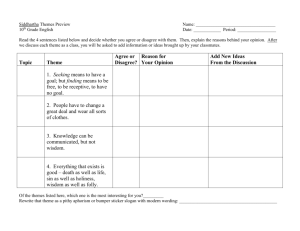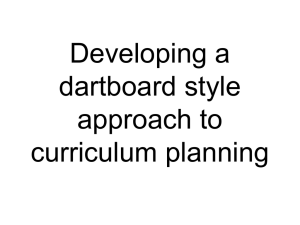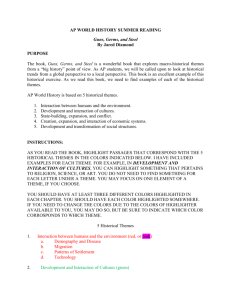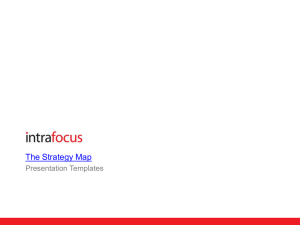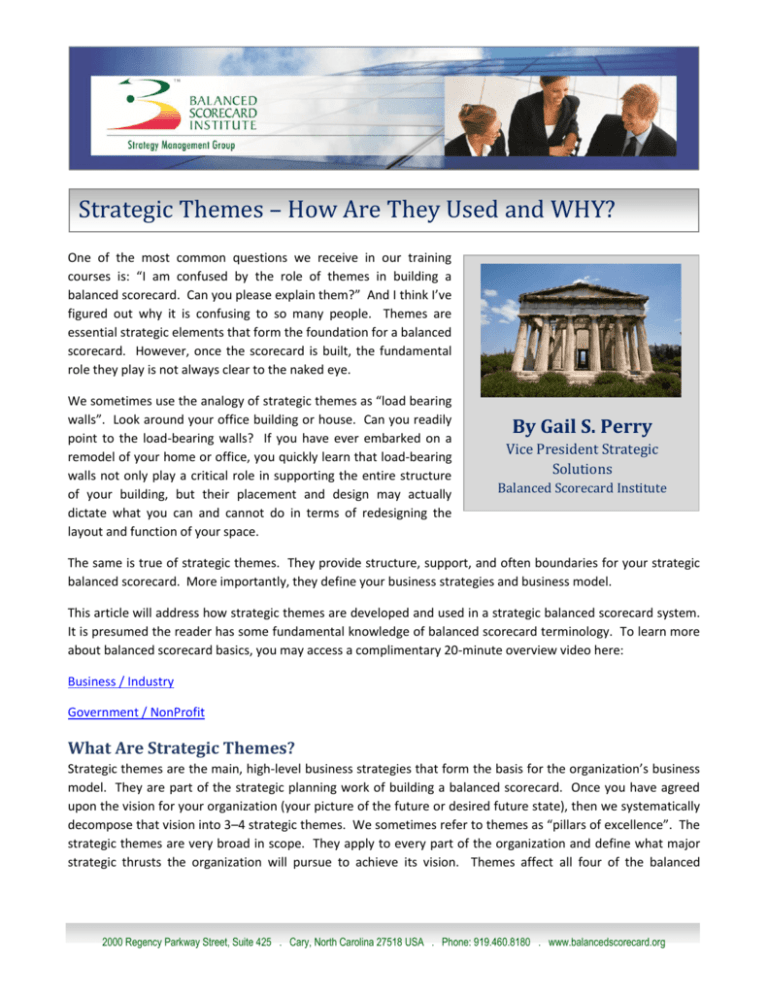
Strategic Themes – How Are They Used and WHY?
One of the most common questions we receive in our training
courses is: “I am confused by the role of themes in building a
balanced scorecard. Can you please explain them?” And I think I’ve
figured out why it is confusing to so many people. Themes are
essential strategic elements that form the foundation for a balanced
scorecard. However, once the scorecard is built, the fundamental
role they play is not always clear to the naked eye.
We sometimes use the analogy of strategic themes as “load bearing
walls”. Look around your office building or house. Can you readily
point to the load-bearing walls? If you have ever embarked on a
remodel of your home or office, you quickly learn that load-bearing
walls not only play a critical role in supporting the entire structure
of your building, but their placement and design may actually
dictate what you can and cannot do in terms of redesigning the
layout and function of your space.
By Gail S. Perry
Vice President Strategic
Solutions
Balanced Scorecard Institute
The same is true of strategic themes. They provide structure, support, and often boundaries for your strategic
balanced scorecard. More importantly, they define your business strategies and business model.
This article will address how strategic themes are developed and used in a strategic balanced scorecard system.
It is presumed the reader has some fundamental knowledge of balanced scorecard terminology. To learn more
about balanced scorecard basics, you may access a complimentary 20-minute overview video here:
Business / Industry
Government / NonProfit
What Are Strategic Themes?
Strategic themes are the main, high-level business strategies that form the basis for the organization’s business
model. They are part of the strategic planning work of building a balanced scorecard. Once you have agreed
upon the vision for your organization (your picture of the future or desired future state), then we systematically
decompose that vision into 3–4 strategic themes. We sometimes refer to themes as “pillars of excellence”. The
strategic themes are very broad in scope. They apply to every part of the organization and define what major
strategic thrusts the organization will pursue to achieve its vision. Themes affect all four of the balanced
2000 Regency Parkway Street, Suite 425 . Cary, North Carolina 27518 USA . Phone: 919.460.8180 . www.balancedscorecard.org
Strategic Themes – How Are They Used and WHY?
Page 2 of 5
scorecard perspectives (financial, customer, internal process, organizational capacity). A strategic theme is an
area in which your organization must excel in order to achieve your vision.
Developing strategic themes requires considerations of other strategic elements, such as the challenges,
enablers, customer value proposition, and other components of the strategic assessment work. Themes also
represent deliberate strategic directional decisions made by the leadership team. Taken together, one can look
at the proposed set of strategic themes and ask this question: “If we excel in these 3-4 areas, will we achieve our
vision?” and receive a resounding answer of “Yes!” This is similar to an engineer looking at an architectural
design and answering this question, “If we put these walls of this thickness in these locations, will the building
stand solid?”
What is a Strategic Result?
Each theme has a “strategic result” associated with it. This is a statement of a desired end-state. In other
words, how will you know when you have achieved the theme? The result is stated in such a way that you will
clearly recognize success when you see it. Strategic results are measurable and explicitly defined using
outcome language. Strategic themes are often similar from organization to organization. Examples include
Business Growth, Operational Excellence, Customer Service Excellence, Innovation, and Sustainability.
However, the strategic differentiator lies in the strategic result. The specificity of the result gives guidance to
organizational transformation. For example, in one organization the result of Business Growth might be “We
supply the electricity products and services our customers need when they need them, now and in the future”
and be measured by a “Build the Business Composite Indicator” (made up of market share, electricity availability
ratio, and a new services customer acceptance ratio). In another organization this same theme might have a
completely different strategic result such as “Our customers choose us over other lenders in all the financial
markets we serve, now and in the future” and be measured by a compound measure of current and futurelooking indicators.
Strategic Elements Form the Structure of the Balanced Scorecard “House”
Figure 1 below illustrates the idea of strategic elements that form the structure of the balanced scorecard
“house”.
The
roof
represents the mission
(what is our purpose) and
vision (what are we trying
to achieve). The balanced
scorecard
perspectives
represent the floors of the
house.
These are the
lenses, the dimensions of
performance through which
we view the organization.
The foundation of the
house
represents
the
human dimensions of the
Figure 1: Strategic Themes are the Pillars that Support the Mission & Vision
2000 Regency Parkway, Suite 425 . Cary, North Carolina 27518 USA . Phone: 919.460.8180 . www.balancedscorecard.org
Strategic Themes – How Are They Used and WHY?
Page 3 of 5
system – without fully engaged leadership and proactive communications and change management, your house
is built on shaky ground. The strategic themes/results are the load bearing walls which support the mission and
vision of the organization and provide stability by linking all the way from the foundation, through each
perspective level, to the roof.
Translating Themes into Strategy Maps
A strategy-based balanced scorecard system involves the collaborative development of an organization’s “Story
of the Strategy” and identifies the connection between capacity, processes, customer value, and financial
outcomes.
In order to map this “story of strategy”, we assemble a team of subject matter experts for the theme and use
their expertise to systematically decompose each theme into a set of strategic objectives, mapped in a story of
value creation, to achieve the desired strategic result. Figure 2 below illustrates how themes are translated into
strategy maps. It is important to note that the leadership team, by setting the themes and results, has
deliberately defined certain strategic boundaries or parameters to give guidance to the theme teams. It is also
important to note that the guidance is broad enough to allow the theme teams to have some creative latitude
to develop the “how” of the strategy – to consider many options for achieving the desired strategic result. So to
continue our load-bearing wall analogy, selecting where to put the wall will, by design, open up or limit options
for the footprint and function of potential rooms within the building.
Figure 2: Well Executed Strategy Leads to Desired Strategic Results
For more reading and examples on developing strategy maps for strategic themes, please refer to these articles:
Building Innovation to your Strategy
Link Sustainability to Corporate Strategy
2000 Regency Parkway, Suite 425 . Cary, North Carolina 27518 USA . Phone: 919.460.8180 . www.balancedscorecard.org
Strategic Themes – How Are They Used and WHY?
Page 4 of 5
The Finishing Touches
Once all the theme maps are developed, they are combined to create a powerful, mutually reinforcing business
strategy (see Figure 3). We are often asked “why” we go to all the trouble of building theme maps when we are
just going to combine them in the end. That is like asking why we go to the trouble of installing the load-bearing
walls when we are just going to plaster over them and they’ll disappear into the woodwork anyway.
Figure 3: Theme Maps are Combined into a Single Tier 1 Map
The reason we are so deliberate about building theme maps is to ensure that you have fully considered the
strategy needed to achieve each strategic result. If you skip this step, you risk missing major objectives that will
be critical to achieve a strategic result. And if you do not achieve your strategic results, you will not achieve your
vision. It’s all connected. In other words, themes ensure the structural integrity of your system.
Another benefit of strategic themes is the opportunity to involve more people (their voices, their experiences,
and their knowledge) in developing strategy through their inclusion on theme teams. This not only results in a
better product, but it contributes greatly to buy-in, understanding, empowerment, and accountability (the
human factors of the system). And buy-in and transparency are key components of changing hearts and minds,
which are critical to transforming an organization into a higher performing entity.
Some clients express concern that themes will “disappear” as they move forward in developing the system, but
this isn’t the case. Most organizations do not present their balanced scorecard in this format, but look at Figure
4. See how we can easily trace the origins of each objective back to the strategic theme(s) that it supports?
2000 Regency Parkway, Suite 425 . Cary, North Carolina 27518 USA . Phone: 919.460.8180 . www.balancedscorecard.org
Strategic Themes – How Are They Used and WHY?
Page 5 of 5
Figure 4: Themes are Traceable on a Tier 1 Map
Summary
The architects of a building always know where the load-bearing walls are. Similarly, the architects of your
balanced scorecard system can quickly show you how your themes are woven through your scorecard. And
when it is time to reassess your strategy, your system architects (usually referred to as the Office of Strategy
Management) can accurately assess what a change in strategic direction (such as a change in mission, vision,
themes, results, objectives) will mean and how to make the necessary adjustments to ensure the ongoing
integrity and alignment of your strategy – to ensure that the strategy you execute is in alignment with your
vision. The strategic themes are the structural supports which ensure the rest of your system is “squared up” to
your mission and vision.
*******************************************************************************************
Gail S. Perry is the Vice President of Strategic Solutions with the Balanced Scorecard Institute. Gail has over 20 years of strategic planning
and performance management consulting experience working with clients such Lockheed-Martin, Vought Aircraft, GulfStream, British
Aerospace, and Ericsson. She has provided consulting, facilitation, and training services for several Institute clients such as ADP, DFAS,
BrightPoint, Pan-Pacific Hotels, the Government of Botswana, Susan G. Komen for the Cure, the Northwest Fire District of Arizona, the
InterAmerican Development Bank, the United Nations Development Program, the U.S. Army Medical Command, U.S. Marine Corps, and
several major commands of the U.S. Air Force. As a lead trainer for several of the Institute’s public workshops, including the certification
programs, Gail has trained several hundred students world-wide. Gail has a degree in Industrial Engineering, an MBA, and is also an
Association for Strategic Planning member. She may be contacted at gperry@balancedscorecard.org.
©2011 Balanced Scorecard Institute, a Strategy Management Group company. All rights reserved. Do not copy without permission.
2000 Regency Parkway, Suite 425 . Cary, North Carolina 27518 USA . Phone: 919.460.8180 . www.balancedscorecard.org



